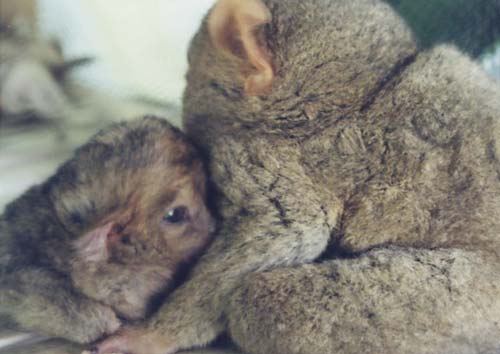Sarangani
tarsiers: A friend for the mom, a playmate for Tarsius Rex
By Rex G.
Ortega / MindaNews

MALUNGON, Sarangani
(MindaNews/8 April 2002) -- It was very much like finding
a friend for a mother tarsier and a playmate for her baby.
Roughly 10 hours
after one of the two captive tarsiers sprung a surprise on
everyone by giving birth on Saturday morning, a mother and
baby tarsier were caught later that evening, bringing to
five the number of tarsiers temporarily kept in captivity
here.
This, as
horticulturist Guillermo Constantino, in whose property
the new arrivals were captured, issued a call to have his
area declared a sanctuary for these strange-looking
nocturnal creatures.
The new arrivals
were introduced into the same cage which serves as the
temporary home of three other tarsiers, one of which,
Tarsius Rex, was born in the morning of that very same
Saturday.
Constantino named
the new baby, Miggi, after Governor Miguel Escobar.
Caretaker Dondon
Rolio caught Miggi at around 4 p.m. and the mother at
around 7 p.m. near a bamboo grove a few meters away from
Constantino's house.
The head and body
length of Miggi's mother was estimated at 4 inches, its
tail around twice that long. Miggi, believed to be just a
few days old, measured around 2.6 inches with a tail of
approximately 3.7 inches.
Miggi and his
mother joined Rex and his mother, plus another juvenile
tarsier in a 1.5 x 2.5 x 2 foot bamboo cage covered with
black nylon net and leaves.
Constantino said
the behavior of the tarsiers when they were put together
was very interesting.
He said he was
amazed at how the maternal instincts were very strong in
these tiny creatures who are thought to be the next
smallest primates in the world.
Constantino said
Rex's mother immediately took Miggi into her care the
moment the young newcomer was introduced into the cage.
She would even drop Rex at times just to devote her full
attention to Miggi who was bigger and obviously a few days
older than her very own baby.
"It looks a
lot like she was comforting Miggi," Constantino said.
Miggi's mother was
clearly stressed from being separated from her baby for at
least three hours and just spent most of her time hiding,
forgetting her own baby.
Rolio, who caught
Miggi and its mother in an ingenious way, said the latter
seemed contented to leave Miggi at the care of Rex's
mother who appeared to have more authority over it.
It could not be
ascertained which of the two mothers was older. The sex of
Miggi, Rex and the other adult tarsier in the cage could
not be determined either.
Constantino
expressed the need to have scientists or tarsier experts
study his "guests." He said he wants to free the
tarsiers soon but would first seek the advice of the
Department of Environment and Natural Resources if he
should release all or keep some for scientists to study.
Constantino, a
member of the Provincial Tourism Council and the younger
brother of Vice Governor Felipe Constantino, originally
had a pair caught just to prove to Sarangani officials
that tarsiers exist here.
The revelation
shocked not only the officials but the rest of the
population as well including those from the neighboring
provinces who thought tarsiers only existed in Bohol.
Constantino
explained the ignorance by saying that only Lumads, like
the B'laans and T'bolis, know the creatures whom they call
"Mal," exist. They believe tarsiers bring bad
luck.
The International
Union for the Conservation of Nature and Natural Resources
(IUCN) classifies the Philippine Tarsier (Tarsius
syrichta) as endangered though the USDI classifies it as
threatened. Tarsiers are jeopardized by destruction of
forest habitat and capture by people.
Proclamation 1030,
issued by then President Fidel Ramos on June 23, 1997,
declared the Philippine tarsier as a "specially
protected faunal species of the Philippines" and said
its preservation is a matter of national concern since it
forms part of the Philippine heritage."
The Proclamation
also prohibits the "hunting, killing, wounding,
taking away, possession of the Philippine tarsier and the
conduct of activities destructive of its habitats"
except for "educational, scientific or
conservation-centered research purposes" upon
certification by the Environment secretary.
Constantino, the
provincial administrator, information officer,
environmental officer, tourism and agricultural officers
will meet tomorrow (Tuesday) to discuss what to do with
the tarsiers who have been discovered to exist in all the
seven towns of Sarangani.
A tarsier sanctuary
just like the one in Bohol is being thought of by some.
(Rex G. Ortega/MindaNews)
|